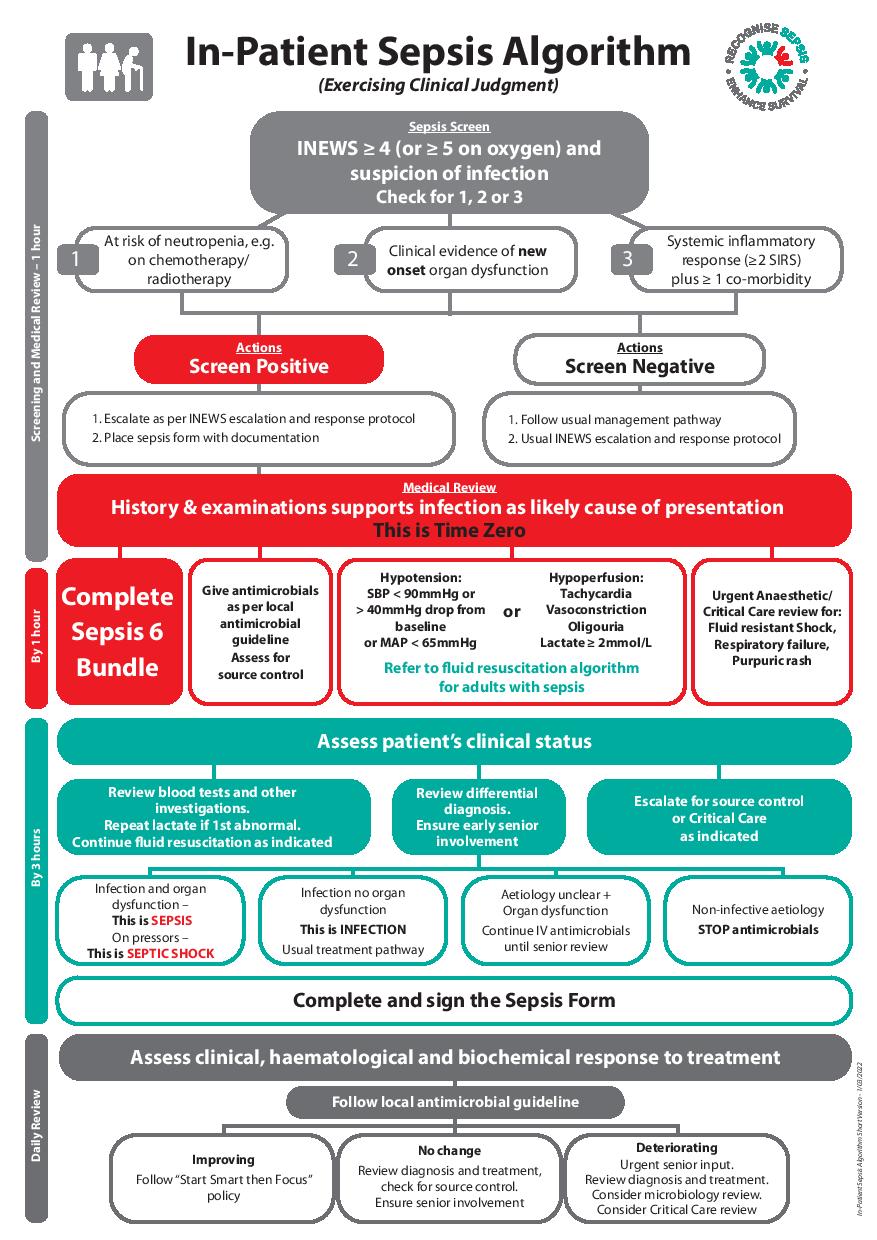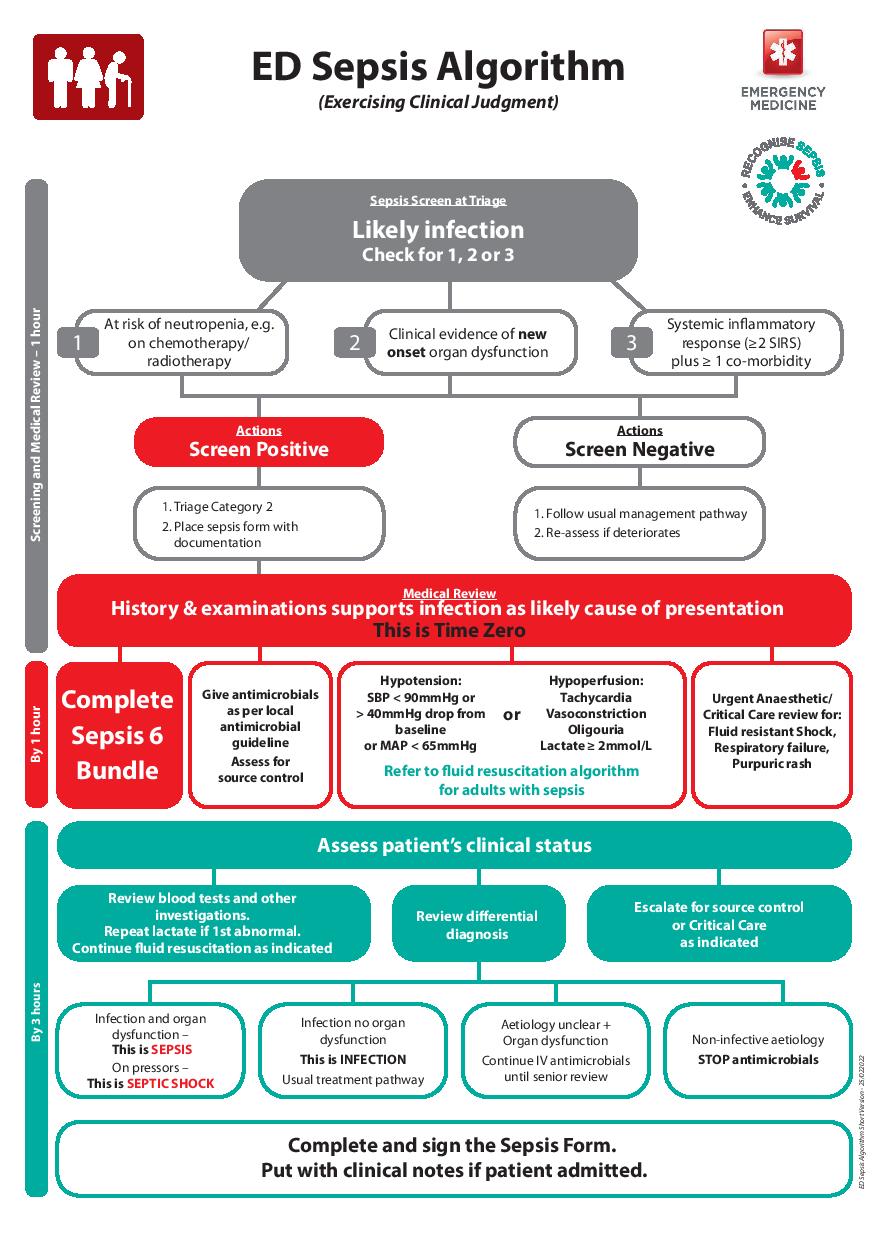Sepsis
Sepsis Undetermined Origin/Source Unclear
|
Sepsis - Undetermined Origin/Source Unclear |
|
General |
|
Assess likely focus of infection –e.g. urinary tract, skin/soft tissue, abdominal, chest, neurological and refer to the organ/organ system-specific sections of these guidelines if source of sepsis is known.
|
|
Antimicrobials |
|
First Line if no obvious source: Piperacillin-tazobactam 4.5g TDS/QDS IV (QDS dosing indication: severe infection, neutropenic sepsis or Pseudomonas aeruginosa infection) + Gentamicin/Amikacin once daily IV (please see Gentamicin / Amikacin dosing schedule) Use Amikacin instead of gentamicin if history of infection or colonisation with gentamicin resistant Gram negative bacteria, severe illness or septic shock + Vancomycin in severe infection, septic shock, or history infection/colonisation with MRSA (Please see Vancomycin dosing schedule) Penicillin allergy NOT IgE -mediated/anaphylaxis/severe reaction: Ceftriaxone 2 g once daily IV + Metronidazole 500 mg TDS IV + Gentamicin/Amikacin once daily IV (please see Gentamicin / Amikacin dosing schedule) Use Amikacin instead of gentamicin if history of infection or colonisation with gentamicin resistant Gram negative bacteria, severe illness or septic shock + Vancomycin in severe infection, septic shock, or history infection/colonisation with MRSA (Please see Vancomycin dosing schedule) IgE-mediated / anaphlyaxis/ severe penicillin allergy: Ciprofloxacin* 400mg BD IV + Metronidazole 500mg TDS IV + Gentamicin/Amikacin once daily IV (please see Gentamicin / Amikacin dosing schedule) Use Amikacin instead of gentamicin if history of infection or colonisation with gentamicin resistant Gram negative bacteria, severe illness or septic shock. + Vancomycin in severe infection, septic shock, or history infection/colonisation with MRSA (Please see Vancomycin dosing schedule)
If history of colonisation or infection with ESBL - producing, OR gram negative bacteria resistant to piperacillin-tazobactam or cephalosporins use Meropenem 1g TDS IV. Note restricted antimicrobial agent, discuss with microbiology. Review need for Gentamicin/Amikacin daily. The use of aminoglycosides in combination with other agents (e.g. co-amoxiclav) is rarely required for longer than 3 days. Discuss with microbiology if required. * Please read the HPRA Drug Safety Alert issued in 2018 and the HPRA Drug Safety Newsletter issued in 2023 highlighting restrictions on use of fluoroquinolones (eg. ciprofloxacin, levofloxacin) due to the risk of disabling, long-lasting and potentially irreversible side effects (including tendon damage, QT prolongation, neuropathies and neuro psychiatric disorder). Use of fluoroquinolones in older patients, those with renal impairment, solid organ transplantation or on systemic corticosteroids increases the risk of tendon damage. |
|
Comments |
|
Neutropenic Sepsis/Febrile Neutropenia
|
Febrile Neutropenia/Neutropenic Sepsis |
|
General points |
|
Neutropenia = An absolute neutrophil count (ANC) of <0.5×10 9 /L, or an ANC of <1.0×10 9 /L and predicted to fall below 0.5×10 9 /L. Fever = A single oral temperature of ≥38.3°C or a sustained temperature of ≥38.0°C for more than one hour. Febrile Neutropenia / Neutropenic sepsis is a medical emergency. IV antimicrobial therapy should be started without delay.
|
|
Antibiotics |
|
First Line: Piperacillin-tazobactam 4.5 g QDS IV See " Indications for Adding a Second Agent " section below regarding indications for additional agents
NOT IgE-mediated/anaphylaxis/severe penicillin allergy: Ceftazidime 2g TDS IV (adjust dose in renal impairment). +/- Teicoplanin/Vancomycin (Please see Teicoplanin / Vancomycin dosing schedule) See " Indications for Adding a Second Agent " section below regarding indications for additional agents
IgE-mediated/anaphylaxis/severe penicillin allergy : Ciprofloxacin 400 mg 8 hourly IV (OR Aztreonam 2g TDS IV if risk of ciprofloxacin toxicity *) AND Teicoplanin/Vancomycin (Please see Teicoplanin / Vancomycin dosing schedule) Add Amikacin once daily IV if high risk of infection (please see Amikacin dosing schedule)
Indications for Adding a Second Agent: Add Teicoplanin/Vancomycin (Please see Teicoplanin / Vancomycin dosing schedule) if history of MRSA colonization/infection OR suspected line-related sepsis OR critically ill OR active mucositis Add Gentamicin once daily IV (see gentamicin dosing schedule ) if high risk of infection ( OR Ciprofloxacin 400mg TDS IV in multiple myeloma/cisplatin-based therapy**) In severe illness, septic shock, OR if history of infection/colonisation with gentamicin resistant Gram-negative bacteria replace Gentamicin with Amikacin once daily in all combinations**. ** In a haemodynamically unstable patient, the benefit of gentamicin/amikacin may outweigh the risk – discuss with haematology consultant. * Please read the HPRA Drug Safety Alert issued in 2018 and the HPRA Drug Safety Newsletter issued in 2023 highlighting restrictions on use of fluoroquinolones (eg. ciprofloxacin, levofloxacin) due to the risk of disabling, long-lasting and potentially irreversible side effects (including tendon damage, QT prolongation, neuropathies and neuro psychiatric disorder). Use of fluoroquinolones in older patients, those with renal impairment, solid organ transplantation or on systemic corticosteroids increases the risk of tendon damage. |
|
Comments |
|
Consider stopping gentamicin/amikacin at 24-72 hours if afebrile, and no Gram-negative pathogen isolated from blood cultures. Other antimicrobials may need to be continued. If pathogen identified, target therapy in accordance with susceptibility results.
If persistent fever on empiric antimicrobials and evidence of clinical deterioration: Re-evaluate patient for potential focus of infection. Contact microbiology for advice –may require escalation of Gram-negative cover +/- Gram-positive cover. Consider addition of anti-fungal agent if fever persists after 3 days. Consider investigations for opportunistic pathogens such as PJP, mycobacteria, viruses, fungi etc. as appropriate |
|
References |
|
Averbach et al. Bacterial: new drugs – duration of therapy – febrile neutropaenia, 10 th European Conference on Infections in Leukaemia, 2024. Averbach et al. European guidelines for empirical antibacterial therapy for febrile neutropenic patients in the era of growing resistance: summary of the 2011 4 th European Conference on Infections in Leukaemia. Haematologica 2013:98(12): 1826-1835. Keck JM, Wingler MJB, Cretella DA, et al. Approach to fever in patients with neutropenia: a review of diagnosis and management. Therapeutic Advances in Infectious Disease . 2022;9. doi: 10.1177/20499361221138346 |
Sepsis in Pregnancy
|
Sepsis in Pregnancy |
|
General points |
|
See below for antimicrobial recommendations for 1. Sepsis in pregnancy (no identifiable source) 2. Severe sepsis (eg. septic shock) in pregnancy.
|
|
Sepsis in Pregnancy (no identifiable source) |
|
First Line (Empiric Therapy) |
|
Co-amoxiclav 1.25g TDS IV + Gentamicin 5mg/kg OD IV (booking weight, max 480mg) (please see Gentamicin dosing schedule). Note: Early escalation to Piperacillin-tazobactam 4.5g IV QDS + Gentamicin 5mg/kg OD IV (booking weight, max 480mg) may be warranted depending on clinical severity, recent microbiology test results or recent co-amoxiclav use.
If history of MRSA colonisation or infection consider adding Vancomycin 15mg/kg IV 12 hourly (booking weight, max 2g/dose), (please see Vancomycin dosing schedule) . Consider 25mg/kg (max 2g) loading dose if severe infection or septic shock. In patients with a booking weight BMI ≥30kg/m 2 use Obese Dosing Weight/Adjusted Body Weight ( Please see formulae for weight calculations ) and not Actual Body Weight to calculate gentamicin dose. (Please see Gentamicin dosing schedule) . |
|
Penicillin Allergy (Empiric Therapy) |
|
NOT IgE-mediated /anaphylaxis/severe penicillin reaction: CefUROXime 1.5g IV QDS. + Metronidazole 500mg IV TDS. + Gentamicin 5mg/kg OD IV (booking weight, max 480mg). (Please see Gentamicin dosing schedule) If history of MRSA colonisation or infection consider adding Vancomycin 15mg/kg IV 12 hourly (booking weight, max 2g/dose). Consider 25mg/kg (max 2g) loading dose if severe infection or septic shock. (Please see Vancomycin dosing schedule).
IgE-mediated /anaphylaxis/severe penicillin reaction: Vancomycin 15mg/kg IV 12 hourly (booking weight, max 2g/dose). Consider 25mg/kg (max 2g) loading dose if severe infection or septic shock (Please see Vancomycin dosing schedule). + Gentamicin 5mg /kg once daily (use booking weight) (Please see Gentamicin dosing schedule) + Metronidazole 500mg IV TDS Add clindamycin if invasive Group A Strep Infection suspected.
In patients with a booking weight BMI ≥30kg/m 2 use Obese Dosing Weight/Adjusted Body Weight (See formulae for weight calculations) and not Actual Body Weight to calculate gentamicin dose. ( Please see Gentamicin dosing schedule ) Note: Both vancomycin and gentamicin can cause nephrotoxicity as an adverse effect. This risk is increased when both agents are used together and is increased further with the use of concomitant piperacillin-tazobactam and other nephrotoxic medications. Review use of these medications daily, monitor renal function and drug levels. |
|
Sepsis (severe) in Pregnancy e.g. septic shock |
|
First Line & Penicillin Allergy (Not IgE-mediated/anaphylaxis or non-severe penicillin allergy) Empiric Therapy |
|
Meropenem 1-2g TDS + Clindamycin 1.2g QDS IV + Gentamicin 5mg/kg OD IV (booking weight, max 480mg) (Please see Gentamicin dosing schedule) In patients with a history of Gentamicin resistant Gram negative infections (eg. UTI) use Amikacin 15mg/kg OD IV (booking weight, max 1.5g). (Please see Amikacin dosing schedule) If history of or risk factors for MRSA colonisation or infection add Vancomycin 25mg/kg (max 2g) loading dose then 15mg/kg IV 12 hourly (booking weight, max 2g/dose). (Please see Vancomycin dosing schedule). In patients with a booking weight BMI ≥30kg/m 2 use Obese Dosing Weight/Adjusted Body Weight and not Actual Body Weight to calculate gentamicin/amikacin dose. (Please see formulae for weight calculation) If there is a strong suspicion clinically that the septic shock may be relating to Group A Streptococcus, then IV immunoglobulin could be considered. |
|
IgE-mediated/anaphylaxis or Severe Penicillin Allergy Empiric Therapy |
|
Vancomycin 25mg/kg (max 2g) loading dose then 15mg/kg IV 12 hourly (Please see Vancomycin dosing schedule). + Clindamycin 1.2g QDS IV + Gentamicin 5mg/kg IV once daily (booking weight, max 480mg) (Please see Gentamicin dosing schedule) In patients with a history of Gentamicin resistant Gram negative infections (eg. UTI) use Amikacin 15mg/kg OD IV (booking weight, max 1.5g) (Please see Amikacin dosing schedule) Ciprofloxacin 400mg BD IV may be added for additional Gram-negative cover. OR Meropenem can be considered for use in select cases (1-2% cross reactivity between penicillin and carbapenem). Discuss with Microbiology/Obstetric teams. + Clindamycin 1.2g QDS IV + Gentamicin 5mg/kg OD IV (booking weight, max 480mg) (Please see Gentamicin dosing schedule) In patients with a history of Gentamicin resistant Gram negative infections (eg. UTI) use Amikacin 15mg/kg OD IV (booking weight, max 1.5g) (Please see Amikacin dosing schedule). If history of or risk factors for MRSA colonisation or infection add Vancomycin 25mg/kg (max 2g) loading dose then 15mg/kg IV 12 hourly (booking weight, max 2g/dose) (Please see Vancomycin dosing schedule).
In patients with a booking weight BMI ≥30kg/m 2 use Obese Dosing Weight/ Adjusted Body Weight and not Actual Body Weight to calculate gentamicin/amikacin dose. (Please see formulae for weight calculation) Review Gentamicin/Amikacin daily with culture results and clinical response. If patient is clinically improving, consider stopping after 48 hours. Note: Both vancomycin and gentamicin/amikacin can cause nephrotoxicity as an adverse effect. This risk is increased when both agents are used together and is increased further with the use of other nephrotoxic medications. Review use of these medications daily, monitor renal function and drug levels. If there is a strong suspicion clinically that the septic shock may be relating to Group A Streptococcus, then IV immunoglobulin could be considered. |
Sepsis Screening Tools
Sepsis Screening Tool for Maternity Patients (up to 42 days post-partum)
Link to National Clinical Guideline: Sepsis Management for Adults (including maternity)
Link to National Clinical Guidelines
Sepsis Management for Adults (including maternity) Sepsis Management for Adults (including maternity) - National Clinical Guideline No. 26 (Version 2) 2025



